 Add
a company
Add
a companyFor an overview of companies and how to manage them see Manage Companies. This topic covers how to add a new company, edit an existing one, or delete a company.

 Add
a company
Add
a company1 Click the Create Company button on the Manage Companies page.

2 Complete the required fields.
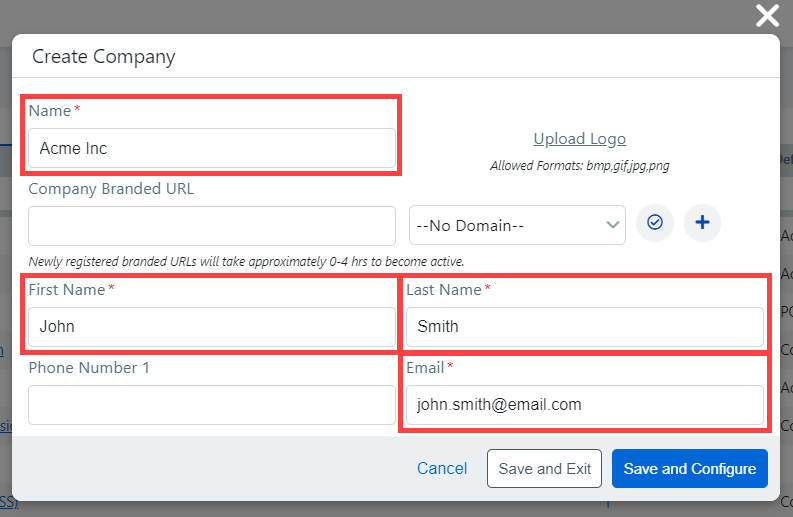
It is best to complete as many fields as possible.
For more information on Company Branded URLs, see Multiple URL Configuration.
3 Click Save and Configure to move onto the Edit Company page.
4 Click Save and Exit to stay on the Manage Companies page.

 Edit
a company
Edit
a companyTo edit a new company
1 Go to Administration > Companies.
2 Click the Create Companies button.
3 Complete the required fields.
It is best to complete as many fields as possible.
4 Click Save and Configure to move onto the Edit Company page.
To edit an existing company
1 Go to Administrator > Companies.
2 Click the appropriate company from the Company Name column to open the Edit Company page.
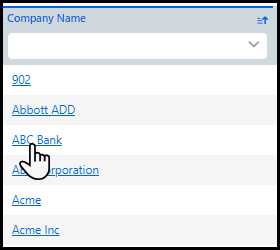
Edit Company page
The Edit Company page is where you configure new companies or edit an existing company. It is divided into seven sections.
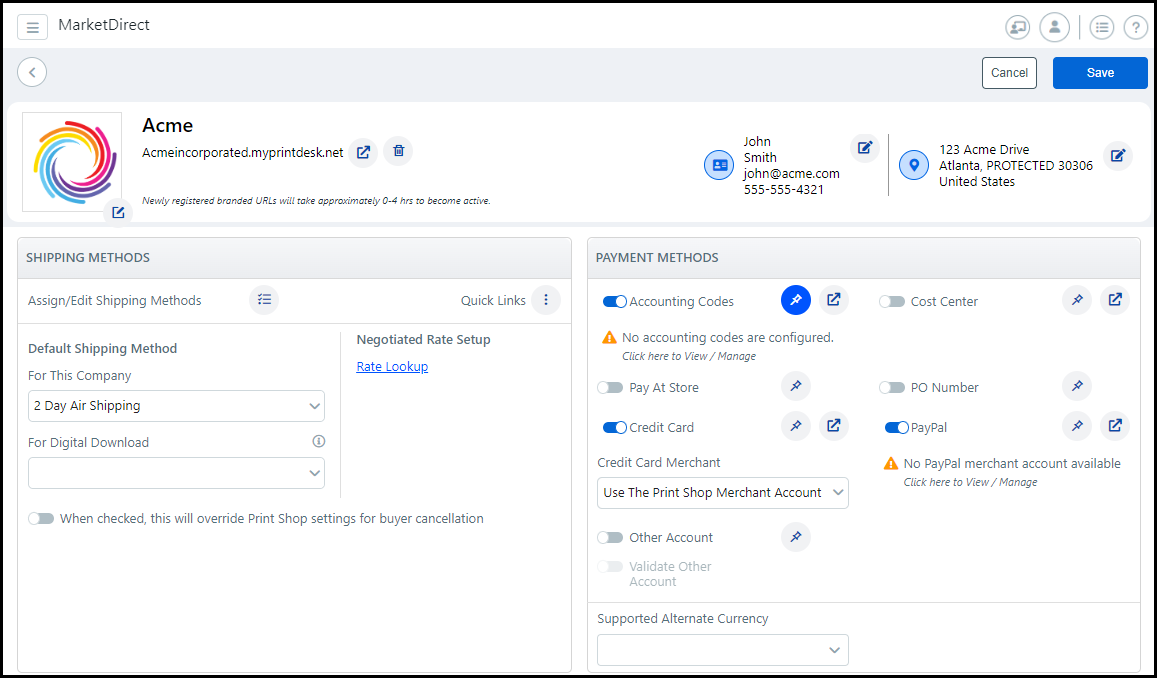
Edit Company page sections
Select the appropriate drop-down list to learn more about each section.
The Company Header is where you edit your company information. It is divided into four sections (Company Logo, Company URL, Contact Information, and Location).

To edit your Company Logo:
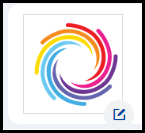
Click ![]() in the Company Logo section to open the Edit Logo
window.
in the Company Logo section to open the Edit Logo
window.

To change your logo:
Click Upload Logo.
Select the appropriate file.
Click Open.
To delete your logo, click ![]() .
.
To enable your logo, select the Display on Storefront toggle.
If you have multiple companies connected to a single storefront, then you can change the StoreFront logo for different user groups.
To add a hyperlink to your logo, enter a URL into the Deep Link field.
Adding a Deep Link is optional. If the field is left blank, then clicking logo will re-direct to the home page.
Click Done when you are finished editing your logo.
To edit your Company URL:

Name: Edit the name of your company.
Company Branded URL: Enter a name for your URL in the Company Branded URL field. Then choose a domain from the No Domain drop-down list.
Click
Check Availability
 to
see if the URL is available.
to
see if the URL is available.
Click Add Domain  to open the Multiple URL Configuration page where you can
add another DNS Zone.
For more information on multiple domain support, see Multiple
URL Configuration.
to open the Multiple URL Configuration page where you can
add another DNS Zone.
For more information on multiple domain support, see Multiple
URL Configuration.
If you choose a domain that is set
to be used exclusively, then you can leave the branded URL
blank and save the entry.
Relational
URL branding: Unless
you use relational branding (or company-branded URLs), visitors
to your site will land on the default storefront (set up in
Storefront
Customization). Using relational or company-branded URLs
you can specify the branding site visitors see when they first
login to a web page (i.e., the login page) or visit your site
(i.e., with anonymous shopping). Site branding (or storefront
customization) in MarketDirect StoreFront
is associated with the company a user is a member of, but
a company is not invoked until a user logs in (because a user's
login profile is associated with a company). So if you want
to apply your custom branding to your site's pre-login homepage,
you will need to enter a name for URL branding to create a
login path with a pointer to the company whose branding you
want users to see. So if you want web visitors to your site
to see a custom-branded company site (i.e., with your logo
and banner) even before they login, use this URL branding.
Otherwise, they will see the default branding for the site
rather than branding tailored to a specific company.
IMPORTANT:
You must associate the relational branded company with the
customized (branded) storefront on the StoreFront Management
page or it will not work properly.
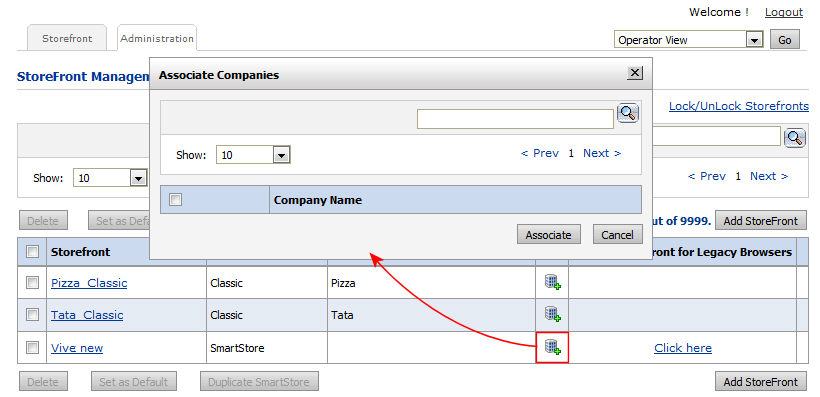
You can access the StoreFront Management page by clicking ![]() for the Assign
Storefront field
in the Additional
Settings section.
for the Assign
Storefront field
in the Additional
Settings section.
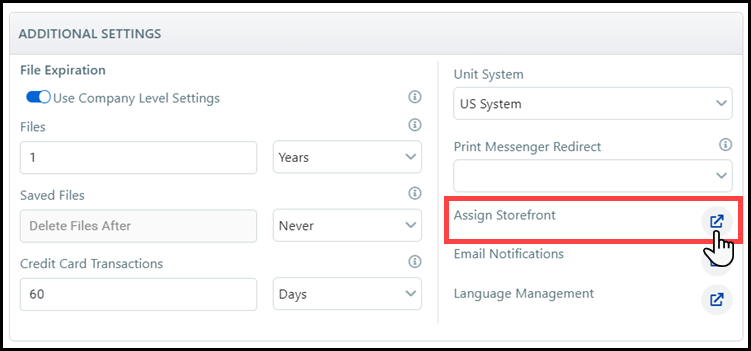
Syntax Format for Standalone (customer-hosted)
sites: Customer-hosted sites will create their own
branding (following the instructions in Storefront
Customization). For example: http://www.[name_of_your_company.com]/dsf/companies/[company_branded_URL]/storefront.aspx
where www.[name_of_your_company.com]
stands for your site’s URL and
[company_branded_URL]
stands for the name of the company (exactly as you configured
it on the Administration
> Companies page).
You can now send users a shortcut via email with your site URL appended with the name of a company that you have custom branded (exactly as it is named in your system). The user will then see your branding on the site home page when first accessing your web site.
Syntax Format for cloud (ePS-hosted) sites: Hosted sites will create their own branding (following the instructions in Storefront Customization). To make it available, you must append a branding pointer to the site URL that the hosting center provides.
Example
- if you have not enabled short URLs for company-branded sites
on the Multiple URL Configuration page will take this form:
http://[your_name].myprintdesk.net/dsf/[asp_number]/companies/[company_branded_URL]/storefront.aspx
where [your_name] is the name you provided to the hosting
center and
[asp_number] is the number you received from the hosting center
(e.g., “asp10”) and
[company_branded_URL] stands for the name of the company (exactly
as you configured it on the Administration
> Companies page) storefront.aspx is the homepage
for your pre-login site.
Example
- if you have enabled short URLs for company-branded sites
on the Multiple URL Configuration page, the URL will take
this form:
http://[your_company_name].myprintdesk.net/dsf/storefront.aspx
where [your_company_name] is the name of your company.
You can now send users a shortcut via email with your site URL appended with the name of a company that you have custom branded (exactly as it is named in your system). The user will then see your branding on the site home page when first accessing your web site.
IMPORTANT: To ensure that visitors to company-branded sites can see only those product categories intended for members of the company the group is branded for, complete the steps in Creating and Editing Product Categories (i.e., on setting security for categories).
Click ![]() to open the company StoreFront.
to open the company StoreFront.
To edit your Contact Information:
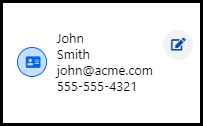
Click ![]() in the
Contact Information
section to open
the Contact Information window.
in the
Contact Information
section to open
the Contact Information window.
Enter the appropriate information and click Update.
You
must complete fields with the red asterisks.
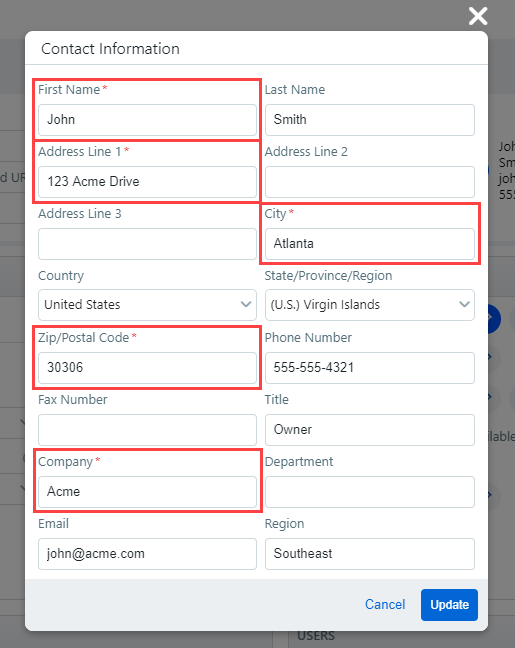
To edit your Location:

Click ![]() in the
Location section to open the Contact Information
window.
in the
Location section to open the Contact Information
window.
Enter the appropriate information and click Update.
You
must complete fields with the red asterisks.

The Delivery Methods section is where you assign and edit the delivery methods for your company. Delivery Methods are enabled and configured using drop-down lists and links to other pages in MarketDirect StoreFront.

Assign/Edit Delivery Methods
1 Click ![]() to open the Assign/Edit
Delivery Methods window.
to open the Assign/Edit
Delivery Methods window.
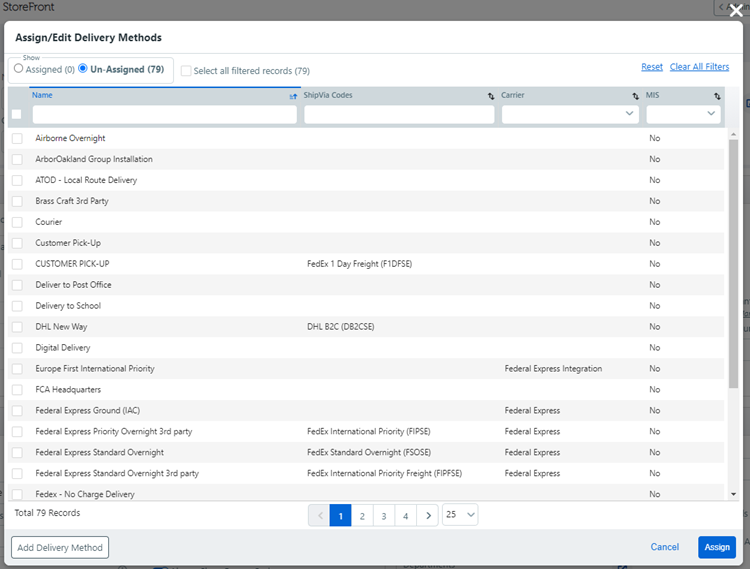
2 To assign a delivery method:
Select the Un-Assigned radio button.
Click the check-box next to the name of the appropriate Delivery Method.
Click Assign.
3 To filter and sort the un-assigned list:
To filter the Name or ShipVia Codes columns, input an alphanumeric search into the necessary field and press Enter.
Click  in the
necessary field or Clear
All Filters to clear the filter results.
in the
necessary field or Clear
All Filters to clear the filter results.
To filter the Carrier or MIS fields, choose the appropriate selection from the drop-down list.
Click  in the necessary field or Clear All Filters to clear the filter
results.
in the necessary field or Clear All Filters to clear the filter
results.
To sort each field,
click ![]() to arrange the list in ascending
order or click
to arrange the list in ascending
order or click ![]() to arrange the list in descending order.
to arrange the list in descending order.
Click Reset to clear all filters and sort options.
4 To edit the assign list:
Choose an Entry Point from the drop-down list.
Click and drag to re-arrange the order of the Delivery Method in the list.
Click to make the Delivery Method the default selection.
You can edit an existing delivery method
on the Delivery Methods page by clicking ![]() in the row for the appropriate Delivery
Method. To access
the Delivery Methods page, go to Administration
> Platform Settings > Delivery Methods.
in the row for the appropriate Delivery
Method. To access
the Delivery Methods page, go to Administration
> Platform Settings > Delivery Methods.
5 To remove a delivery method from the assign list:
Select the Assigned radio button.
Click the check-box next to the name of the appropriate Delivery Method.
Click Assign.
6 Click the Add Delivery Method button to open the Add Delivery Method page.
For more information on adding a delivery method, see To add a delivery method.
Default Shipping Method
The Default Shipping Method drop-down lists are populated with your Assigned delivery methods.
1 Choose a default shipping method for your company from the For this Company drop-down list.
2 Choose a default shipping method for digital downloads from the For Digital Download drop-down list.
The For Digital Download default shipping method is optional and can be left blank.
Negotiated Rate Setup
The Negotiated Rate Setup list is where you update or edit the account information for a shipping carrier enabled for negotiated rates.
1 Click the appropriate shipping carrier to open the Shipping Carrier window.
2 Complete the necessary fields and click Save.
For more information on negotiated rates, see ExpressRater Negotiated Rates.
Quick Links
1 Click ![]() to open the list of quick links for different shipping configuration
tasks.
to open the list of quick links for different shipping configuration
tasks.
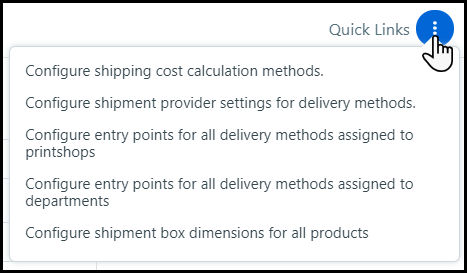
Configure shipping cost calculation methods links to the Shipping Cost Configuration tab on the Site Settings page.
Configure shipping provider settings for delivery methods links to the Delivery Methods page.
Configure entry points for all delivery methods assigned to printshops links to the Print Shops page.
Configure entry points for all delivery methods assigned to departments links to the Departments page.
Configure shipment box dimensions for all products links to the Manage Products page.
Fore
more information on each of these pages, see the appropriate
topic:
Site Settings
- Shipping Cost Configuration Tab
Delivery
Methods
Add or Edit Print
Shop
Managing Departments
Product
Management Contents
The Payment Method section is where you enable and configure the acceptable payment methods for your company. Payment Methods are enabled and configured using toggle switches, drop-down lists, and links to other pages in MarketDirect StoreFront.
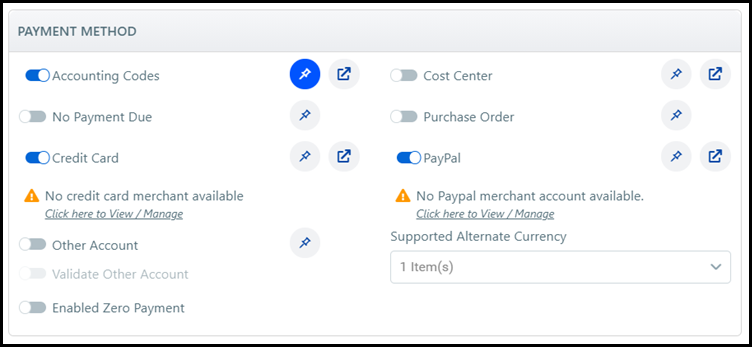
Payment Method Options
Accounting Codes
No Payment Due
Credit Card
Other Account
Other Accounts are used for buyers who wish to control their own payment IDs (i.e., provide whatever data they want to provide).
Validate Other Account
Validate
Other Accounts will
only be available if you enable Other
Account as a supported
payment method.
Select this option if you want to require buyers to enter data
(e.g., account codes) in the Other Account payment
method field (i.e., they cannot leave the field blank and
proceed to checkout).
If you do not select this option, buyers will be able
to place an order without entering anything in the Other Account
field. (The option "validates" only that the
buyer has entered some data in the Other Account field.)
Enable Zero Payment
Cost Center
Purchase Order
PayPal
Enable and Configure the Payment Method
1 Select the appropriate Payment Method toggle switch to enable the Payment Method option.
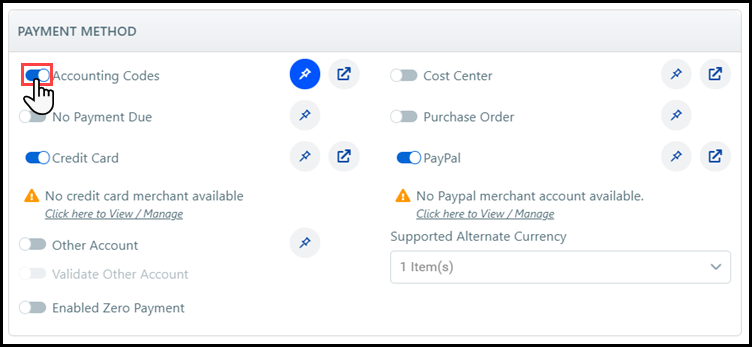
2 Click ![]() for the appropriate Payment
Method to link you
to another page where the Payment
Method can
be configured.
for the appropriate Payment
Method to link you
to another page where the Payment
Method can
be configured.
You can also select Click here to View/Manage to link you
Accounting Codes links to the Accounting Codes page.
Credit Card links to the Merchant Accounts page.
Cost Center links to the Cost Centers page.
PayPal links to the Merchant Accounts page.
Fore
more information on each of these pages, see the appropriate
topic:
Accounting Codes
Merchant
Accounts
Cost Centers
3 Click ![]() to make the selected Payment
Method the default
payment for your company.
to make the selected Payment
Method the default
payment for your company.
4 Choose other accepted currencies from the Supported Alternate Currency drop-down list.
You can select as many alternate currencies as you want.
The Shopping Cart section is where you configure the buyer experience for your company storefront shopping cart. Settings are enabled and configured using toggle switches and drop-down lists.
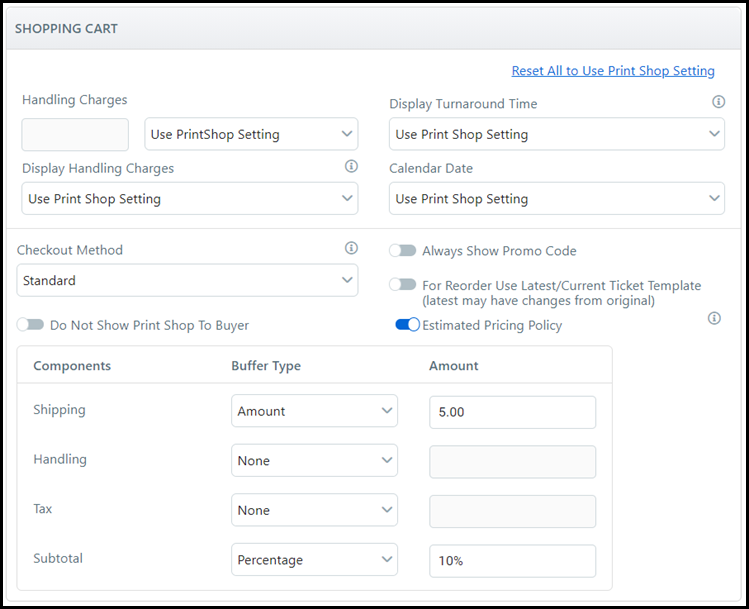
Shopping Cart Settings
Handling Charges
Choose the appropriate option from the drop-down list.
Use Print Shop Setting: uses the handling charge specified at the Print Shop level.
Percentage: adds a handling fee as a percentage of the line item amount (i.e., for items that are either shipped or held for pickup). Specify the percentage in the text box.
Amount: adds a specified handling fee to each line item (i.e., that is either shipped or held for pickup). Specify the amount in the text box.
Display Handling Charges
Choose the appropriate option from the drop-down list:
Use Print Shop Setting: uses handling charge settings specified at the Print Shop level.
Display Handling Charges: handling charges are listed as a separate line item in the shopping cart.
Do not display Handling Charges: handling charges a listed as a line item in the shopping cart.
Checkout Method
Choose the checkout workflow the company will use when a buyer places an order:
Standard
Rapid Checkout
Very Rapid Checkout
Workflow chart:
Standard Checkout Workflow |
Rapid Checkout Workflow |
Very Rapid Checkout Workflow |
1. Click Proceed to Checkout. |
1. Click Proceed to Checkout. |
1. Click Proceed to Checkout. |
2. Specify shipping options on the Shipping page. |
2. Specify shipping options on the Shipping page. |
2. Specify shipping options and payment options in the Rapid Checkout pop-up window. |
3. Click Proceed to Payment. |
3. Click Proceed to Payment. |
|
4. Specify payment options on the Payment page. |
4. Specify payment options in the Rapid Checkout pop-up window. |
|
5. Click Place My Order. |
5. Click Place My Order. |
3. Click Place My Order. |
|
Buyers skip the Payment page in the checkout process. |
Buyers skip the Shipping and Payment pages in the checkout process. |
All Payment Types are supported. |
Payment Types Supported: -Pay at Store -Cost Center -Accounting Codes -PO Number |
Payment Types Supported: -Pay at Store -Cost Center -Accounting Codes -PO Number |
1.
Rapid and very rapid checkout support only the following four
payment methods:
-Pay At Store
-Cost Center
-Accounting Codes
-PO Number
If the company has any other supported payment methods, rapid
checkout will not work and the system will default to the
standard checkout workflow.
2. If Pay
At Store is
the only payment method defined for the company, the Proceed
to Checkout button will take the buyer directly to the
Order Confirmation page (bypassing the Rapid Checkout pop-up
window).
3. If Pay
At Store is
the only payment method and only one delivery method is defined
for the company (i.e., and thus does not require buyer input
to select a carrier), the Proceed to Checkout button
will take the buyer directly to the Order Confirmation page
(bypassing step 2 in the Very
Rapid checkout
workflow described immediately above).
If you configure either Rapid or Very Rapid checkout, it is recommended that you let your buyers know what to expect during the checkout process.
In Very Rapid checkout, the order will be shipped to the address in the buyer's profile. Please ensure that buyers have their addresses updated in their profile because for delivery methods that require an address (i.e., those that are not Customer Pick-Up), very rapid checkout has the order shipped to the buyer's default profile address.
Do not show Print Shop to buyer
Turn the toggle switch on to hide references to the Print Shop from buyers on the following pages:
Storefront
Shopping Cart
Order Checkout
Order Summary
My Account-Profile
My Account-Selected Print Shop
The Print Shop will also not be shown on the Storefront menu bar, and the Print Shop selection field will not be shown on the user registration page.
Display Turnaround Time
Choose the appropriate option from the drop-down list:
Use Print Shop Setting: uses Turnaround Time settings specified at the Print Shop level.
Display Turnaround Time: the Turnaround Time for each item in the order is displayed to buyers in the shopping cart at the line item level.
Do not display Turnaround Time: the Turnaround Time is not shown to the buyers in the shopping cart.
The Turnaround Time for products is set in the Turnaround Time field on the Settings tab of the Manage Products page.
Calendar Date
Use Print Shop Setting: uses Calendar Date settings specified at the Print Shop level.
Preselect earliest date in the calendar: MarketDirect StoreFront automatically sets the due date and time as the earliest regular (i.e., non-rush) time available based on the turnaround time you specified in the Turnaround Time field on the Settings tab of the Manage Products page.
The Preselect earliest date in the calendar option prevents the buyer from having to select a due date on the calendar before proceeding with checkout.
Force user selection of date in calendar: the buyer must select a due date on the calendar before proceeding with checkout. This option lets buyers see the turnaround time for each product (e.g., in a multi-product order) and then choose whether to accept the default date calculated (based on the turnaround time you specified in the Turnaround Time field on the Settings tab of the Manage Products page) or to specify an earlier date on the calendar and see the applicable rush hour charges for expediting the order.
Do not display due date to buyer: the due date and time are not shown to buyers in the shopping cart.
Always Show Promo Code
Turn the toggle switch on to always show the Promo Code field in the shopping cart even when promo codes are not in effect.
Turn the toggle switch off to only show the Promo Code field in the shopping cart when promo codes are in effect.
For Reorder Use latest/current ticket template
Turn the toggle switch on if you want the system to use the latest version of the ticket template for the product, which may have been updated with additional options or otherwise modified. If this option is selected, and the buyer chooses to reorder a product or saved job with a changed ticket template, the system will check the product type to see if it supports automated ticket upgrades.
If the product type supports automated upgrades and the product's ticket information is different from when this order was placed, then a new job is created as if the buyer clicked Begin. If the product allows for buyer configuration, then the older ticket options are migrated into the new job if they are still able to be honored.
If the product does not support automated ticket upgrades or the ticket template information remains the same, then the system will simply copy the job and put it into the cart.
If the product does not support automated ticket upgrades or the ticket template information remains the same and the ticket template has changed, then buyers will be alerted that changes have been made to the ticket template with a link to a Print options have changed alert in the shopping cart. If buyers are allowed to configure the product, they can click the link and on the resulting ticket page view a side-by-side comparison of the original versus the new ticketing options. They may also select new print options available in the new ticket template.
For
Reorder Use latest/current ticket template applies
to products of the following types:
-Ad hoc
-Static
-VDP (ePS VDP and FusionPro)
For information on specifying how reorders for Static
Document Products
are handled when the content (i.e., a file or files in the
product) has changed since the buyer last ordered the product,
see Reorder
File Behavior.
Estimated Pricing Policy
Turn the toggle switch on to configure an estimated pricing policy.
In some cases, MarketDirect StoreFront is not able to calculate the actual tax and shipping charges for an order, so the order prices in the shopping cart are estimated rather than actual. Configuring an estimated pricing policy will help you manage how this "subject to change" information is communicated to buyers in the shopping cart to prevent unexpected discrepancies between the estimated price quoted in the shopping cart and the actual price charged to the buyer's account when enough data is available to render actual amounts.
You can also set an estimated pricing policy at the Site level so that it will be applied to all orders placed on your site (for more information, see Configuring Pricing Settings) or at the Print Shop level (for more information, see Estimated Pricing Policy-Print Shop Level).
Estimated pricing can be configured for the following types of charges:
Shipping: shipping charge for delivery the order.
Handling: handling charge you assess for the order (picking, packing, packing materials).
Tax: tax assessed on the order.
Subtotal: price of the order before shipping, handling, and tax charges are added.
The Shipping and Handling estimated prices are combined and reflected in the Shipping line item in the Shopping Cart.
Choose a Buffer Type from the drop-down list for the appropriate charge:
None: the calculated amount for the element is considered an estimate and communicated to the buyers via a message.
Amount: the estimated price of the element is increased by a fixed amount.
Percentage: the estimated price of the element is increased by a percentage.
Enter a numerical value for Amount buffer or the Percentage buffer into the Amount field.
For
example, a 5.00 Amount
buffer type will
add a fixed amount of $5.00 (or 5 units in the selected currency)
to the estimated order total in the shopping cart.
A 5 Percentage buffer type will add a percentage
amount of 5% to the estimated order total in the shopping
cart.
For sites integrated with an MIS:
If you want to use the estimated pricing feature, make sure
that your MIS supports receiving buffer values. If it does
not, do not use estimated pricing because doing so could result
in errors during the order process.
If
you do not want to communicate that prices for any of the
order elements (shipping, handling, tax, subtotal) are estimated
rather than actual, you do not need to do anything. By default,
MarketDirect StoreFront
does not communicate to buyers that amounts are estimated
rather than actual. If you want to override this default and
communicate that prices in the shopping cart are estimated
rather than actual following the steps below.
Note that the estimated values are labeled "Estimated"
and prefixed with an asterisk that directs buyers to a message
stating that the final charges will be calculated when the
order is completed: "Your order contains estimated amounts;
final charges will be calculated upon completion of your order.
If paying by Credit Card, the initial authorization may not
reflect the final total. You will only be charged for the
final amount." The buffer applied to the subtotal will
have the label "Subtotal Adjustment." Please note
that the message and labels are customizable using MarketDirect StoreFront's
Language Management string customization tools (for more information
see the topic Language
Management - Customize Strings - Company Level).

Note that the estimated pricing policy settings place at the
time an order is placed will be retained even if the estimated
pricing policy settings are changed after the order is placed
(i.e., the buffered amounts will be retained for a specific
order as they were calculated at order placement).
Reset All to Use Print Shop Setting
Click to reset all Shopping Cart Settings to the Print Shop settings configured on the Print Shop page.
The Users section is where you enable and configure user settings for your company. Settings are enabled and configured using toggle switches, drop-down lists, and links to other pages in MarketDirect StoreFront.
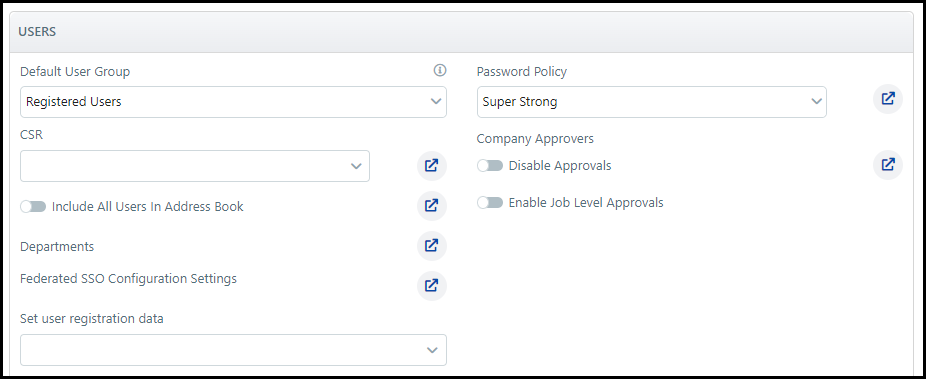
Default User Group
Choose the appropriate user group from the drop-down to assign a user group to the company. When a user self-registers to the company, they will belong to the default group.
You can assign users to a different group on the Groups page. For more information on user groups, see Managing Groups.
CSR
Choose a customer service representative, or CSR, from the drop-down list to assign a CSR that is authorized to place orders for this company.
For more information on CSR management, see Managing CSRs.
Include all Users in the Address Book
Turn the toggle switch on to include all users assigned to this company in the address book.
Click ![]() to open the
Address Book.
to open the
Address Book.
Select an entry to edit and make changes to an existing address.
To add a new address:
Click Add New.
Enter the necessary information for the address.
Required fields are marked with an asterisks and shaded in yellow.

Click Save and repeat the process to add new entries to the company Address Book.
Click Back to return to the Edit Company page.
Departments
Click ![]() to open a list of Departments
for the
company.
to open a list of Departments
for the
company.
For more information on editing existing Departments or adding a new Department to the company, see Add or Edit a Department.
Password Policy
Choose a Password Policy users must follow when creating a password from the drop-down list.
Click ![]() to add a new Password
Policy to
your company.
to add a new Password
Policy to
your company.
For more information on adding a new password policy to your company, see Managing Password Policies.
Company Approvers: An approver is a representative of the company who is designated to approve the purchase of orders submitted by users associated with this company.
For more information on approvals, see Approvals.
Disable Approvals
Turn the toggle switch on to disable approvals for the company.
Click ![]() to open the Company Approvers page
where you can assign approvers to the company.
to open the Company Approvers page
where you can assign approvers to the company.
Click Add Approver then select an approver from the list and click Add.
Click
Edit to change an approver's status, click Reassign
to assign to a different approver, or click Delete
to delete the approver.
You
can also add an Automatic Approval Limit by
clicking Edit
and entering a currency
amount in the
text box. The Automatic
Approval Limit allows
all orders below the currency amount to be automatically approved.
Enable Job Level Approvals
Job level approvals let approvers approve or decline each job within an order rather than only approving or declining the entire order. With job level approvals, approvers can also make changes to a job. For example, the approver might opt to change the quantity, binding type, Media choice, or other attributes of a job to adjust the price before approving.
Turn the toggle switch on to enable job level approvals for the company.
Federated SSO Configuration Settings
The Federated SSO Configuration Settings section will be shown on the Manage Company page only if (1) you have activated the licensed option Authentication Pkg: LDAP and Login Bypass and (2) you opted to let the federated SSO (Single Sign-On) settings be configured on a per-company basis. Federated SSO can also be set up for the entire site (site-level SSO) on the Federated SSO Configuration Settings page. For more information on Federated SSO user authentication, see Directory Services Authentication-LDAP-Hosted. For more information on User Authentication in MarketDirect StoreFront, see User Authentication.
Click ![]() to
open the Federated SSO Configuration Settings page
where you can set up single sign-on for the company.
to
open the Federated SSO Configuration Settings page
where you can set up single sign-on for the company.
Set user registration data: Select the User Profile Fields to display when a new user registers for this company. If there are no fields selected from the Set user registration data drop-down list, then new user registration fields will default to the site level settings determined on the Site Settings > User Profile Fields tab.
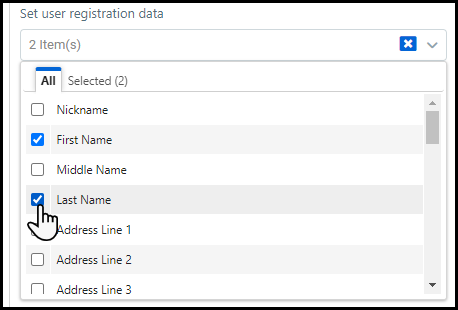
All site level settings in the Site Settings > User Profile Fields tab will be available in the drop-down list. Marking a field as required can only be done at the site level on the User Profile Fields tab. For more information, see Site Settings - User Profile Fields Settings
Initial group access
Choose the user group that will get manage access to the new company.

The Initial group access setting will only be available if you select Save and Configure after creating a new company.
1
Click ![]() to open the Federated SSO Configuration Settings page.
to open the Federated SSO Configuration Settings page.
2 Choose the authentication method by which users access this company:
This company's users authenticate with the company's own federated SSO system: Select this option if you want users associated with this company to login via the company's own federated SSO authentication system.
This company's users authenticate within this MDSF site, with the MDSF user name and password: Select this option if you want users associated with this company to login via the standard authentication method of entering a valid username and password combination.
3 In the Federation Server Connection section, configure the connection:
This
section will be shown only if you select the option This company's users authenticate
with the company's own federated SSO system in the
previous step.
The settings in this section are site-level settings that govern
how MarketDirect StoreFront
connects with the federation system. Once the URL is entered,
the fields will be automatically populated.
Federation Server's Metadata
Click Browse... and, on the File Upload dialog, navigate to and select the federation metadata XML file.
The metadata XML URL depends on the ADSF server setup. In most cases, if the ADSF server is "myadfs.mycompany.com", the metadata URL will be found at "https://myadfs.mycompany.com/FederationMetadata/2007-06/FederationMetadata.xml". This URL can be found in the ADSF server's ADSF 2.0 Manager in "AD FS 2.0 / Service / Endpoint" in the Metadata section.
Click Open.
Click Upload.
Issuer Name ID: This is the ADFS server's unique identifier URL. It can be found in ADSF 2.0 Manager in "AD FS 2.0 / Service / Properties / General / Fderation Service Identifier".
Issuer Passive Redirect URL: The is the URL to which MarketDirect StoreFront will direct the web browser to request login. It can be found in ADSF 2.0 Manager in "AD FS 2.0 / Service / Endpoints / Token Issuance / SAML 2.0/WS-Federation".
Valid Issuers: This is the list of issuer name IDs from which MarketDirect StoreFront will accept XML login tickets. This should typically contain a copy of Issuer Name ID.
Token Signing Cert. Thumbprints: This is a hash/thumbprint of the ADFS server's token signing certificate. In can be found in ADSF 2.0 Manager in " AD FS 2.0 / Service / Certificates / Token-signing / View Certificate / Details / Thumbprint".
Token Encryption Symmetric Keys: This is used only when XML login ticket encryption is manually set up. By default, MarketDirect StoreFront does not request the token encryption and this field should be left blank.
Other Connection Settings
Notify the federation server about the Logoff actions: Select this option to notify the federation server when a user logs out.
Force SSO for any user entering this site on behalf of the company: Select this option if you want to mandate that all users who login to this company enter via SSO user authentication.
Pricesheets is where you select the price sheet and configure the price settings for your company. Settings are enabled and configured using toggle switches and drop-down lists.

Base Price Sheet
Choose the base price sheet from the drop-down list to specify the default price sheet for users associated with the company.
You
can use only one price sheet per company.
If you do not set
pricing at the company level, pricing will default to the
pricing set at the Print Shop level. If no pricing is set
at the company or Print Shop level, pricing will default to
the default site-level pricing.
For more information
on pricing and price sheets, see Pricing
and Define Special
Pricing.
Print Shop Pricing: If you want to use Print Shop pricing, choose Use Print Shop Setting from the Base Price Sheet drop-down list.
Print Shop pricing is configured on the Print Shop page.
Special Company Pricing: If you want to use special company pricing, which can be customized for your company, then choose the appropriate price sheet from the Base price Sheet drop-down list.
Exemptions to the Base Pricesheet
Click ![]() to open a copy of the selected base
price sheet in the company's Pricing page where you
can customize the price sheet for the company.
to open a copy of the selected base
price sheet in the company's Pricing page where you
can customize the price sheet for the company.
Each individual customization is counted
as an exemption. The number of exemptions of each price sheet
are listed in the Exemptions
to the Base Pricesheet field.

1 From the Base Price Sheet drop-down list, select the published price sheet to use.
2 To add an exception
(for instance if you want to give members of the company a
special price on Green paper), click ![]() in the Exemptions to the
Base Pricesheet field
to open a copy (for this company only) of the base
price sheet in the company's Pricing page.
in the Exemptions to the
Base Pricesheet field
to open a copy (for this company only) of the base
price sheet in the company's Pricing page.
3 From the View By drop-down list,
on the pricing page, select the component category filter
(Print Services, Media,
Impressions, Products, Shipping) whose price you want to review.

4 Scroll down to view the price sheet.
5 To edit the price of a component, click Edit for it to open the price sheet editor.
The price sheet editor is arranged into 6 tabs:
Price Sheet Details
Print Services
Media
Impressions
Products
Shipping
Select the tab for the component whose price you want to edit.
Select the [component] Type to edit from the pull-down list.
Range Unit used in pricing the component. The range unit enables administrators to set price breakpoints at which pricing for the component will increase or decrease.
Billing Unit used in pricing the component. The billing unit is independent of the range unit (which is used for establishing price breakpoints) and specifies the unit of the component that is priced.
Only site administrators can edit the range and billing units. For more information on how to edit price sheets, see Overview of the Pricing Model.
Change the regular and setup pricing for the component as needed.
6 When finished, click Save And Go Back.
7 Click Done to return to the Manage Company page.
Markup or Markdown Prices
Turn the toggle switch on to add a percentage markup or markdown to different components of your company pricesheet.
The Markup or Markdown Prices setting allows you to make temporary price changes to a price sheet without having to edit or create a new price sheet.
Enter a numeric value into the Percentage field for the Component price you want to change.
Select ![]() to Markup
the component by the percentage entered into the
Percentage field.
to Markup
the component by the percentage entered into the
Percentage field.
Select ![]() to Markdown the component by
the percentage entered into the Percentage
field.
to Markdown the component by
the percentage entered into the Percentage
field.
Turn the toggle switch on for the Apply to Setup Price option to add the markup or markdown percentage to the setup fee associated with the altered components.

Unit Price Visibility
Choose whether you want to show or hide unit prices for buyers or inherit the setting from the site level.
The Unit Price Visibility setting for the site level is configured in the Settings tab on the Price Sheet Management page.
Storage Pricing
Choose the storage pricing for the company from the drop-down list.
Show Inventory To Buyer
Turn the toggle switch on to show inventory data to buyers registered to this company.
Show Pricing To Buyer
Turn the toggle switch on to show pricing information on the storefront (e.g., when browsing the catalog, in the shopping cart, etc.) to buyers registered to this company.
If you leave this box unchecked, no pricing information will appear anywhere on the buyer UI/storefront for this company (regardless of login credentials; thus, even administrators will not be able to see pricing when they are viewing pages on the storefront). A typical use for hiding pricing is for in-plants where it is not necessary for buyers to see pricing information.
Show Pricing To Approvers
Turn the toggle switch on to show pricing to approvers registered to this company.
You may want to disable this setting if approvals in your organization are based on the content of order and not price so that approvers who belong to the company will not see an Order Total on the Approvals page for orders that are placed by users in any company.
Show Shipping Methods with Price
Turn the toggle switch on to show the shipping methods with their estimated cost to the buyer in the shopping cart.
This setting only works if the Show Pricing To Buyer and the Perform Shipping Calculations settings are enabled. The Show Pricing To Buyer setting is located in the Price Sheet(s) section of the Company page. The Perform Shipping Calculations setting is located in the Settings tab on the Price Sheet Management page.
This setting is enabled by default for new and existing SmartStore 2.0 StoreFronts using the shopping cart 2.0.
Disable rush fee for this company
Turn the toggle switch on to disable rush fees for jobs processed through this company.
This will completely disable the rush fee and rush functionality for the company, including the ability to select a Rush Date/Time from the calendar.
Allow Tax Exemption
Turn the toggle switch on to allow tax exemption for the company. You must upload a Tax Exemption Certificate for the field to be valid.
Click  to open the
Upload Tax Certificate window.
to open the
Upload Tax Certificate window.
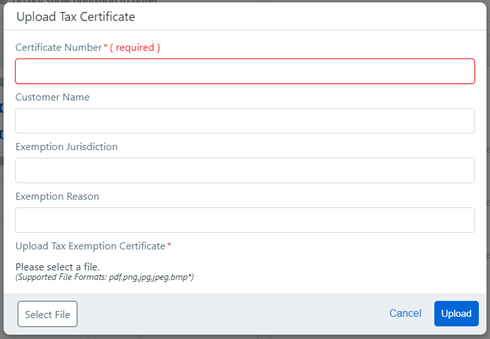
Enter a Certificate Number.
Click Select File and choose the Tax Exemption Certificate.
Supported file formats are pdf, png, jpg, jpeg, and bmp.
The Customer Name, Exemption Jurisdiction, and Exemption Reason fields are optional.
Click Upload.
The Additional Settings section is where you configure the remaining settings of your company. Settings are enabled and configured using toggle switches, drop-down lists, and links to other pages in MarketDirect StoreFront.
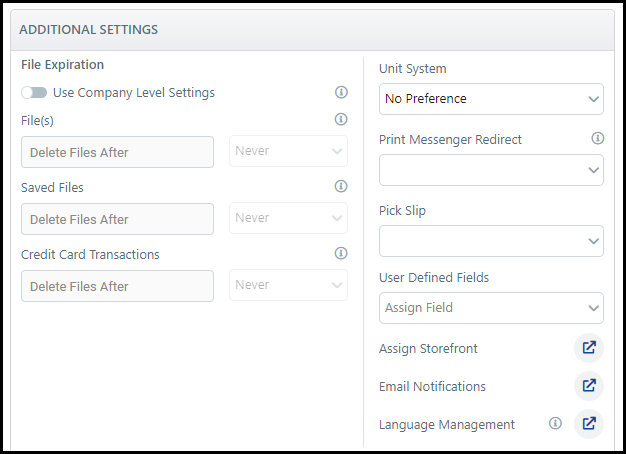
File Expiration
File
Expiration specifies
how long customer files will remain in the system before begin
deleted.
The accumulation of customer-uploaded files can deplete your
system resources (hard drive space). Over time, these job
files need to be deleted to free up disk space. The accumulation
of files can deplete your system resources and impair performance.
It is recommended that you set a reasonable time limit for
storing files in your system and specify when they should
be deleted automatically. If you need to archive your files,
consider a backup option that will preserve your data but
free up system resources.
Changing this setting will affect the shopping cart and buyers’
saved jobs, and, if set too low, can cause the system to delete
job files unexpectedly. File expiration should be long enough
to provide customers with enough time to place orders with
the uploaded file.
Please note that any changes you make to the file expiration
settings will take effect for new files and will not affect
existing files.
Use Company Level Settings
Turn the toggle switch on to specify file expiration settings for this company that are different from the file expiration settings you have specified at the site-level.
For information on how to configure file expiration settings at the site-level, see File Expiration.
Choose an increment of time (Never, Days, Years) from the appropriate File Type drop-down list.
Enter
a numeric value in the Delete
Files After for
the appropriate File
Type.
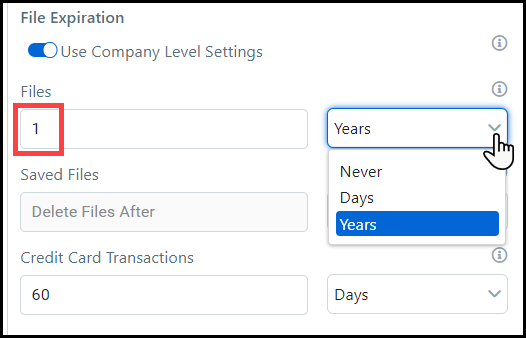
File
Types include:
-Files are
the files buyers upload when creating products such as ad
hoc and VDP. These files include images, text documents, CSV
data list files, images saved to galleries, etc. and both
the original files converted PDF files.
-Saved Files are the files buyers have saved
for later use.
-Credit Card Transactions
are the files associated
with credit card order transactions.
Unit System
Choose the unit system of measurement to use for the company from the drop-down list.
For more information on unit systems, see Site Settings - Unit System Tab.
Print Messenger Redirect
Print Messenger Redirect enables you to associate a particular product with the Print Messenger so that when buyers submit a job through Print Messenger they will be taken immediately into the associated product's workflow (the Visual Product Builder) in MarketDirect StoreFront without having to manually select the product to link to the submitted file.
Choose the default product to link with the Print Messenger from the drop-down list.
The drop-down list will include ad hoc defined for the company that are published to the Featured Products category.
For more information on
Print Messenger Redirect, see PrintMessenger
Redirect.
You can also set Print Messenger
Redirect at the
site-level. Fore more information, see Site
Settings - PrintMessenger Redirect Tab.
Pick Slip—(For MarketDirect Fulfillment users only):
Choose a Pick Slip from the drop-down list that will be used to generate a Picking / Packing Slip when a line item is released for the company.
If you do not select a Pick Slip for the company, then the default PickSlip report will be generated.
User Defined Fields
Assign User Defined Fields to the company.
Choose to assign the fields either to the Order or Line Item from the drop-down list.
Select the fields to assign to the company from the User Defined Fields window.
Click Assign.
For more information on User Defined Fields, see User Defined Fields.
Assign Storefront
Click ![]() to open the StoreFront Management page
where you can assign the storefront to a company.
to open the StoreFront Management page
where you can assign the storefront to a company.
For more information on the StoreFront Management page, see Storefront Customization.
Storefront Customization
Click ![]() to open
the SmartStore Builder page where you can customize
the look and feel of your company storefront.
to open
the SmartStore Builder page where you can customize
the look and feel of your company storefront.
For more information on using the SmartStore builder, see SmartStores - Building and Editing.
Storefront Customization will only be available after the storefront is assigned to a company.
Email Notifications
Click ![]() to open
the Email Notifications page where you can edit the
company-level email notifications.
to open
the Email Notifications page where you can edit the
company-level email notifications.
For more information on customizing your email notifications, see Email Notifications.
Language Management
Click ![]() to open
the Language Management page where you can override
the default field labels and UI text on your company
SmartStore storefront.
to open
the Language Management page where you can override
the default field labels and UI text on your company
SmartStore storefront.
Text strings used to describe features, Media, products, etc. cannot be overridden.
For more information on customizing language strings for your company, see Language Management - Customize Strings - Company Level.

 Delete
a company
Delete
a companyTo delete using the Quick Access menu
1 Go to Administration > Companies.
2 Hover on ![]() for the appropriate company.
for the appropriate company.
The default company cannot be Deleted.
3 Select Delete.
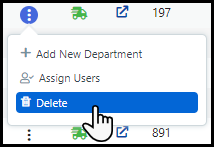
4 Click OK in the Delete window.
To Delete using the item selection box
1 Go to Administration > Companies.
2 Click the column header box to select all companies in the table.
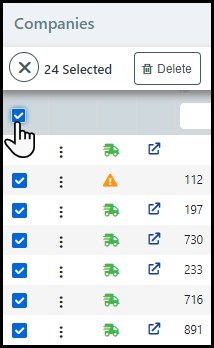
3 Click the box on an individual row to select a specific company in the table.
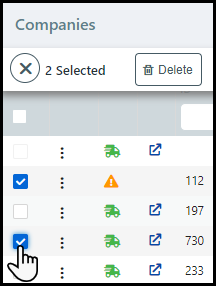
4 Click the Delete button in the header.

Click the Cancel
button or each item
selection box to cancel the deletion process.
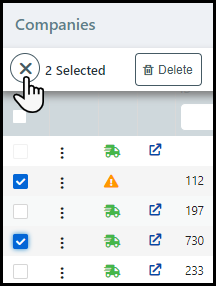
5 Click OK in the Delete window.
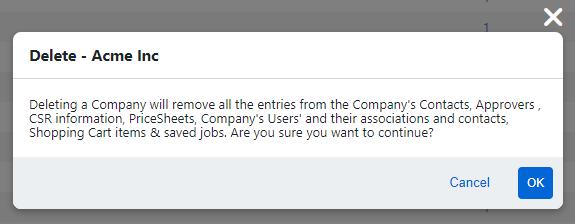
Deleting a company will remove information associated with that company, and it cannot be recovered once Deleted.
● Overview of Managing Companies